This easy no-knead dutch oven bread has a crispy crust and a tender, moist and chewy crumb. Proofing the dough in the InstantPot is a genius hack and a game-changer. It is ridiculously simple and time-efficient! Read on to learn how you can make this really easy no-knead artisan bread!
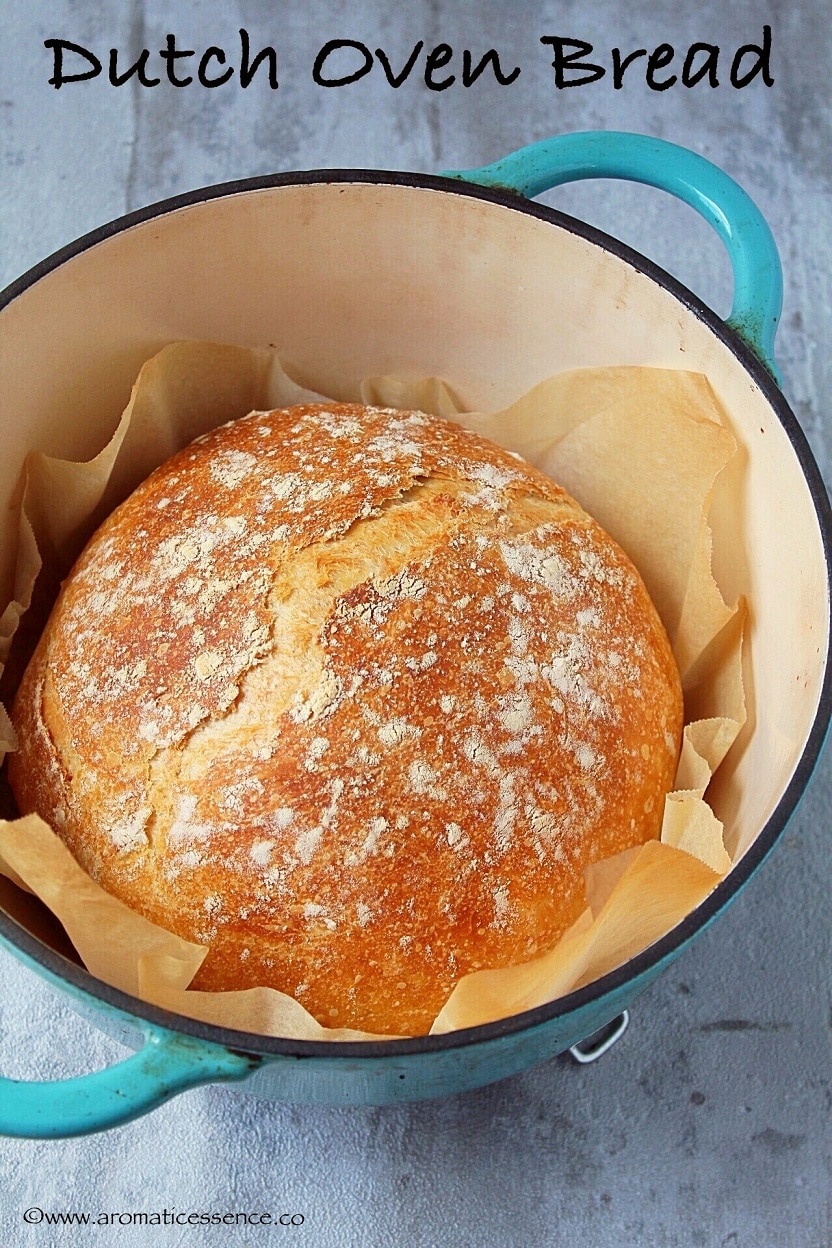
It’s been a while since I’ve shared a bread recipe here. So, I’m more than happy to share this Dutch oven bread recipe with you guys.
I know many people find dealing with yeast a nightmare in itself, but honestly, it is not intimidating. And if you are a beginner in bread baking, then this is an easy recipe to start with.
Baking bread does require patience, some amount of elbow-grease, and practice. But thanks to this classic recipe from Jim Lahey, owner of Sullivan street bakery in New York City, the life of an average bread baker has been simplified!
This recipe requires no professional baking skills, zero-kneading, and is so darn easy. You really are missing out on something if you haven’t tried this yet!
You guys! That finished boule just out of the oven with that perfect, deep brown crust is a joy to behold. The only way to experience this is by making one.
Table of Contents
What is no-knead bread?
No-knead bread is just what it sounds! The dough is not kneaded in this recipe, rather the ingredients are simply mixed to form a shaggy dough. It is then left to sit for a good 18-24 hours. During this fermentation time, the yeast does all the work, creating gluten strands, which give strength and elasticity to the dough.
Another typical thing about no-knead bread is that it requires a small quantity of yeast and a very wet dough aka higher hydration dough.
The long rise imparts so much flavor to the overnight no-knead bread, it has a nice airy crumb and crackly golden-brown crust! It is perfect to enjoy with some butter, dunk in soups or simply transform them into sandwiches!
The bread is baked in a Dutch oven. The relatively thick walls of the dutch oven retain the heat and the tight-fitting, oven-safe lid helps traps the steam. Steam is an important factor to achieve a crispy crust. You can read more about the role of steam in bread baking here.
In short, a dutch oven imitates a similar baking environment used by professional bakers creating a rustic loaf of bread that looks just like the ones in your favorite bakery.
A wet dough, long fermentation time, and a dutch oven are all you need to make this easy no-knead bread.
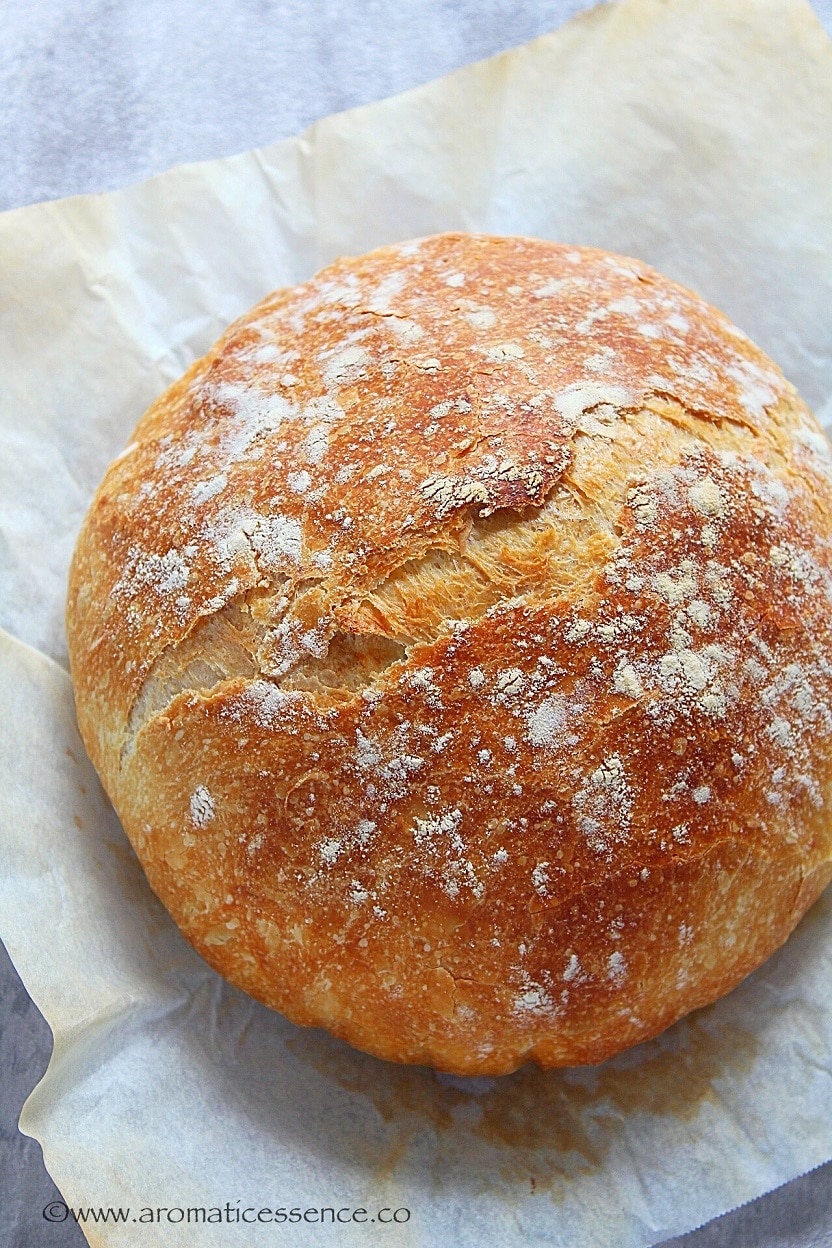
Why use the Instant Pot to proof the dough anyway?
The simple answer is to save time! With the help of the electric pressure cooker, you can prove this no-knead dough in just about 4 hours as opposed to 18-24 hours required otherwise.
So even if you forget to prepare the dough the previous night, you can still make some fresh, homemade crusty bread in the morning and enjoy it for lunch or get it ready by dinner. You don’t have to wait for an entire day!
It is a real time-saver IMHO, and even perfect during these winter months when the yeast activity is lowered.
This method of proofing dough in the Instant Pot is perfect to make all kinds of bread, be it Challah, dinner rolls, brioche, baguette, French bread, and pita bread to name a few. If it is a regular kneaded dough you would just require about 30 minutes to proof in the IP, which again is a bonus in the winters!
Note: You must have the yogurt function to be able to proof the dough in the Instant Pot. Don’t worry, even if you don’t have one, I’ve listed a few alternatives below.
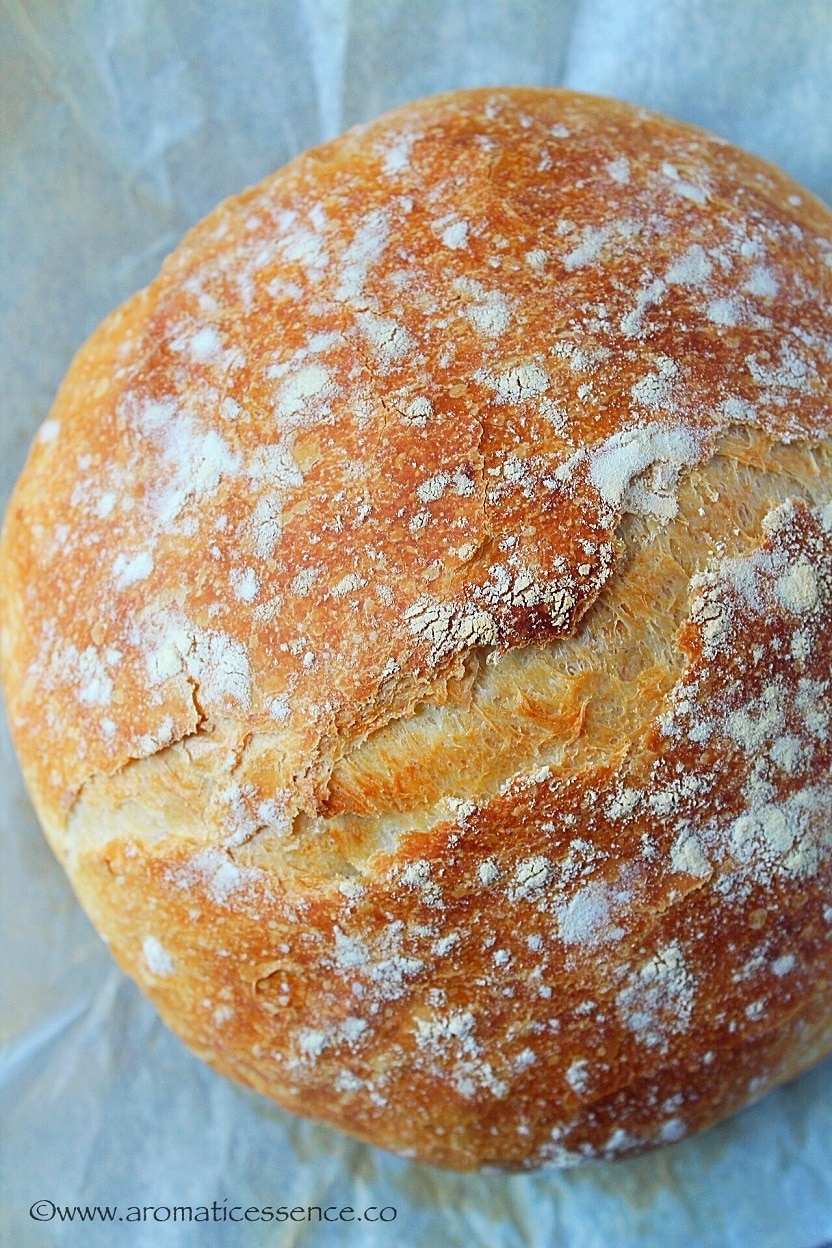
Tips to make the best no-knead dutch oven bread
1. Yeast
Make sure your yeast has not expired. If you use expired yeast, the dough is never going to rise.
What kind of yeast to use? Active-dry, instant or rapid-rise yeast, all work equally well in this recipe. I’ve used active-dry yeast for this recipe in the past, without activating it, and the dough proofed just as well.
Tip: If you are unsure whether the yeast is active, heat the water called for in the recipe below to 105-110 degrees F. Add the yeast, and a teaspoon of sugar, mix well, and set aside. If it turns frothy and bubbly, you are good to go. Simply add that water to the rest of the ingredients and proceed with the recipe.
Remember: Once you open a fresh jar of yeast, it has to be refrigerated for longer shelf life. If you do not bake often, then try and use those 1/4 ounce yeast packets preferably.
2. Measuring ingredients accurately
This dutch oven bread recipe is so simple and yet, even more, simpler to mess it up. Having made this countless times, I can tell you the quantity of ingredients i.e flour and water, play an important role. Too much flour and you will end up with a dense loaf of bread, using more water will result in such a sticky mass, that you are going to find it challenging to shape the dough. So follow these 2 steps really well,
Measuring the flour
It is advisable to always weigh ingredients using a weighing scale. However, if you do not possess one, follow the procedure below.
First fluff the flour by stirring it with a spoon, then spoon the flour into the measuring cup. Do not tap the cup on the counter, then use the back of a knife to level off the excess flour by running it across the measuring cup.
Always spoon the flour after aerating it into your measuring cup. Never scoop out the flour using the measuring cup directly, you always end up packing more flour than the recipe calls for.
The amount of water
I have reduced the amount of water in my recipe after reading an awesome tip in this post from Serious Eats. The water that the original recipe calls for had created an extremely sticky dough, which was really difficult to shape, meaning I would end up using an excessive amount of flour to shape it.
Using more flour can result in a dense bread. I understand the water required can differ greatly depending on the humidity, and other conditions.
By reducing the water, I still had that shaggy, sticky dough, and needed way lesser flour to shape it. I think it is a great tip to follow as you also end up with a beautiful looking crusty boule that is not too dense!
The preferred ratio of ingredients for this no-knead bread recipe is 100 parts flour, 70 parts water, 1.5 parts salt, and 1 part instant yeast.
Also, you don’t really need to use warm water for this recipe. Regular water works just as well, and that is what the original recipe calls for.

3. Shaping this sticky shaggy dough
This might seem complicated if you are just beginning, as it can be a challenge to shape this kind of dough. I’ve had a few failed attempts. I would get so frustrated that I would just dump the dough in the dutch oven, but the bread always tasted great, no matter how bad the shape of the dough was.
A simple solution is to use a bench scraper to shape the dough. You can refer to the handy video for this process, as I thought it would be best to simply explain using a video tutorial.
4. The right yogurt setting
You must make sure the yogurt setting is set to ‘LESS’ or ‘NORMAL’. Setting it to ‘HIGH’ can kill the yeast, also the bottom of the dough will begin to dry out and start to cook. I prefer to use the ‘less’ setting, I’ve had consistent results with it.
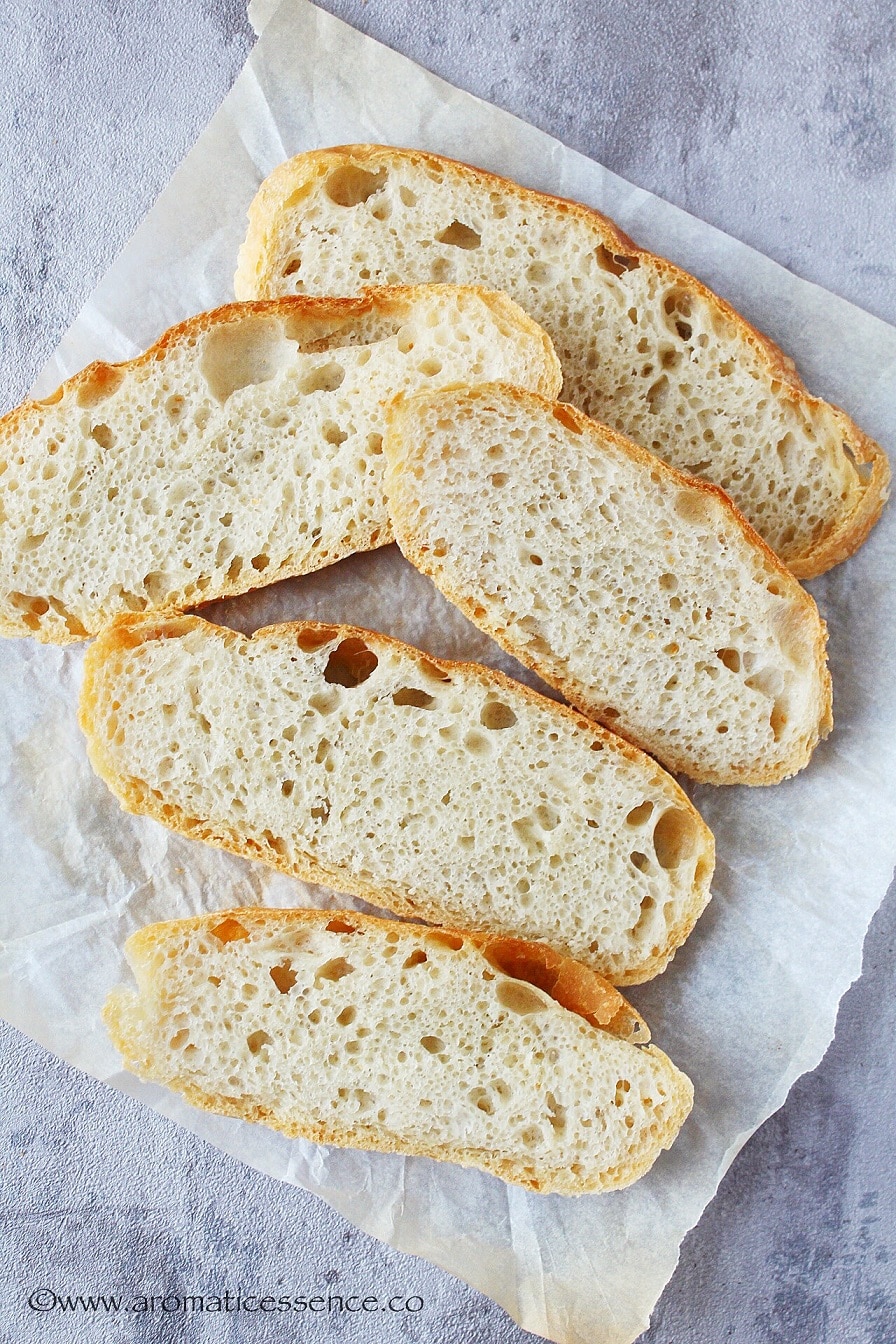
What to serve with this artisan bread?
This flavorful crusty bread is good with just about anything.
- Slather some butter and jam and enjoy the simplicity of this fresh homemade bread. This Instant pot strawberry jam is really delicious as is this mango jam if you’d like to try it out.
- Serve it alongside your favorite soups.
- Use the slices to make your favorite sandwich!
Try these different add-ins
While this Instant pot bread is so good on its own, I always love varying and switching it up with some add-ins.
You can add these in the second step while mixing all the ingredients. Below are some of my favorites;
- Garlic/roasted garlic & rosemary
- Seeds
- Warm spices like cinnamon
- Jalapeno cheddar
- Cranberry & walnuts
- Fresh or dried herbs
- Cheese
- Raisins

Quick FAQs
Which is the best flour for no-knead bread?
I recommend using bread flour to make any kind of bread. Bread flour is the preferred choice of flour to make these rustic bread recipes with a thin crust and chewy crumb. It has more protein content than all-purpose flour, which helps in better gluten development. If you don’t have it, you can use all-purpose flour, a direct 1:1 substitution will work just fine.
Can I use gluten-free flour?
Yes, you can swap the bread flour with gluten-free flour for a loaf of gluten-free bread. Simply use a 1:1 substitution. But, keep in mind, that the bread won’t be the same as the original. It will differ slightly in taste and texture.
Can I use whole wheat flour to make this bread?
You can use part whole wheat flour and part bread flour/all-purpose flour for a less dense loaf of bread. Using 100% whole wheat flour will result in an extremely dense bread. If you still choose to go in for whole wheat, I suggest adding 3 tablespoons of vital wheat gluten along with the rest of the ingredients. That will ensure you have a lighter loaf of bread.
Why is my no-knead bread dense?
The bread could be dense because you probably added more flour than that called for in the recipe. The dough is meant to be sticky, so avoid adding excess flour.
Can I use the ‘KEEP WARM’ setting to ferment the dough?
The temperature range of the ‘keep warm’ setting is between 145 to 165 degrees F which is not feasible for proofing the dough. It can get really hot, and that will kill the yeast. So, I do not recommend doing that.
I don’t have the yogurt setting, can I still make this Instant Pot bread?
Of course, you can still make this bread. It will only take longer for the fermentation process. Either of these following alternatives will work well;
- Keep it on the countertop for 18-24 hours, just as the original recipe states. Below is a pic of the dough proofed on the countertop for 18 hours.

- If you want to accelerate the fermentation process, pre-heat the oven to the lowest setting for 10-15 minutes. Then switch it off, and turn on the light. Place the bowl, covered with a lid in the warm oven. Proof for about 4-6 hours or until the dough has risen and is bubbly. I always used this method to ferment my idli dosa batter while I was in the US, and it always worked like a charm in the winters. The warmth of the oven light is good enough to speed up the fermentation process.
If you have more interesting ways, please leave a comment below. I’d be happy to add to this list for the benefit of others.
Can I bake bread in the Instant Pot?
Technically, you would be steaming the bread rather than baking it in a pressure cooker. Honestly, I’ve yet to try baking it directly in my IP. The bread will not have that crusty surface, rather it will be soft. I do hope to try this someday and will update that result here. And, if you have tried it, please share your feedback in the comments below.
What should I use to cover the insert of the IP while proofing the dough?
I’ve always used the lid of the IP to cover the pot while I proof the dough, without any problems.
It is not really a necessity to use the lid, as we aren’t sealing the apparatus. The yogurt function does not cause the pot to pressurize, it simply maintains the ideal temperature for incubation.
Though I have to caution you, you need to be careful here. A few folks have mentioned this on Facebook groups. If left to proof for too long, the dough can rise and push the pin up, which will lock the lid. It is really a hassle to open the lid.
So I’d advise you to use any other lid or a plate, or simply cover the pot with a heavy-duty aluminum foil.
What is the size of the dutch oven required for this recipe?
I’ve baked this bread in a 5 quart enameled dutch oven. A 3.5 quart will also work well for this recipe. I’m not sure about using a bigger dutch oven with these quantities, I think the bread might spread out more due to the larger surface area of the pot and turn flat.
Do I need to grease the bottom of the dutch pot to prevent the bread from sticking?
No, you don’t need to. If the pot is super hot, the bread won’t stick. Also, I prefer to dump the dough all along with the parchment paper. It also makes it easier to remove the loaf of bread after it is done. Please use good quality parchment paper.
If not using parchment paper, dust a little cornmeal on the bottom of the pot.
Do I need to score this no-knead bread before baking?
Scoring is a term used for slashing the dough before baking. The bread is not only scored to decorate it, but it also serves a purpose. The intentional slashes in the dough allow the loaf to expand in the right direction during baking.
Without scoring, there are chances of the bread cracking in random places.
I’ve yet to gain some confidence in scoring this kind of bread because it is a high hydration dough. Mine tends to look more messy than pretty. So, all I do is just dump the dough ball, and the bread still ends up looking pretty good and it tastes awesome as well!
Can I make this crusty bread without a dutch oven?
Yes, you can definitely make this no-knead bread without a dutch oven. You can use;
- A pizza stone: Preheat the pizza stone as you would with the dutch pot. Then carefully transfer the dough (simply lift the dough in the parchment paper) onto the pizza stone. Cover the dough with a stainless steel pot or bowl that is oven safe up to 500 to 550 degrees F. Bake as directed in the recipe, remove the pot/bowl carefully after 30 minutes, and let the bread bake for another 15 minutes.
- Or use the stainless steel pot such as a soup pot that is oven-safe up to 500 to 550 degrees F, and cover it heavy-duty aluminum foil. Make sure that the handles are oven-proof and not plastic. There is no need to preheat the steel pot.
- A cast-iron skillet: Grease the bottom and sides of a 10 or 12-inch cast-iron skillet, transfer the dough ball onto the skillet, cover and let it proof for 30-45 minutes. Preheat the oven to 450 degrees F during the last 20 minutes, place the cast iron skillet on the middle rack, and bake and bake for 45-50 minutes
By using any of these above methods, make sure that the lid is covered tightly because you need that steam to have a finished loaf of boule with a crusty exterior and an airy crumb.
Again, if you have more interesting alternatives to the dutch oven, please leave a comment below. I’d be happy to add to this list above.
How to store homemade bread?
Bread is best eaten the day it is baked. If I have some left, I store mine in a breadbox. If you don’t have one, wrap the loaf of bread in aluminum foil, or place it in a paper bag and store it in a cool, dark place for up to 2 days.
Avoid refrigerating bread as it can dry it out.
How to freeze homemade bread?
Once the bread has cooled completely, slice the bread. Wrap individual serving portions (like 2 slices) in an aluminum foil, or cling wrap or resealable plastic bag and press out the air. Place everything in a large freezer bag and freeze for up to 3 months. Remember to label the contents along with the date.
Pre-slicing the bread helps to avoid defrosting the entire loaf of bread, especially when you need only a few slices.
Thaw the bread slices on the countertop or microwave it for 20-30 seconds or pop it in the toaster directly from the freezer.
How to make no-knead dutch oven bread – Step by step instructions
Step 1: Prepare the Instant Pot
Line the inner pot with parchment paper, grease with oil spray or a tablespoon or two of olive oil.

Step 2: Combine the dry ingredients
Combine 3 cups/430 grams bread flour, 1.5 teaspoons kosher salt, and 1/2 teaspoon of yeast in a big bowl, and whisk well.
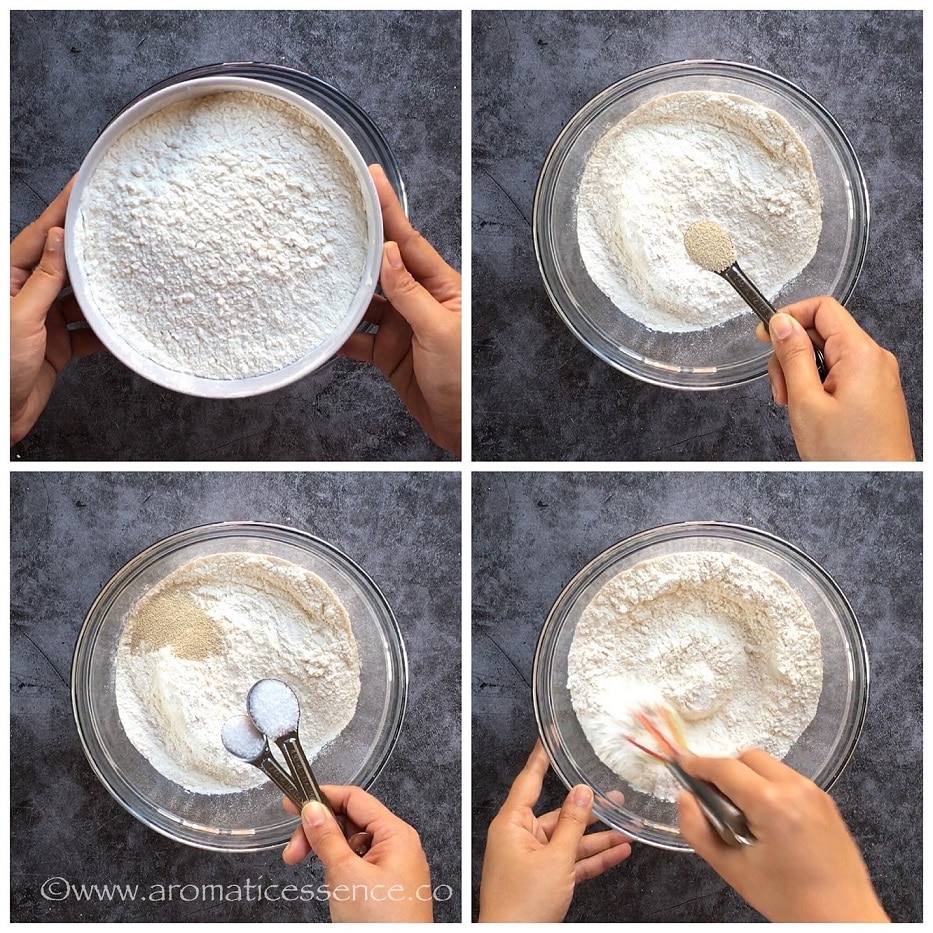
Step 3: Add water and olive oil
Add 300 ml of water and 2 tablespoons of olive oil, stir well with the help of a spatula or wooden spoon, until all the flour has mixed well with the water, and no dry flour pockets remain. The dough should look shaggy and be sticky at this stage. If not, add a few tablespoons of water, about 2-3 tablespoons should suffice.

Step 4: Transfer the shaggy dough to the inner pot
Transfer the dough to the greased parchment paper, cover the pot with any other lid or a plate or even aluminum foil. As a precautionary step, avoid using the lid of the IP.
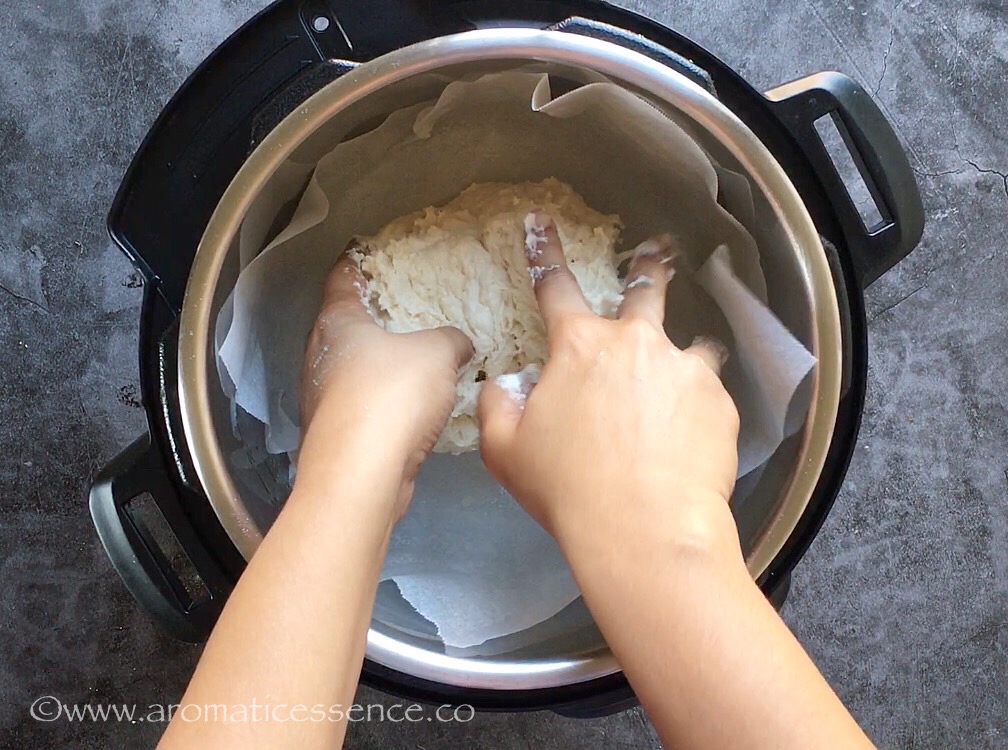
Step 5: Proof the dough in the Instant Pot using the ‘YOGURT’ function
Press the ‘YOGURT’ button, set it to ‘LESS’ OR ‘NORMAL’ setting. Set the timer for 4 hours using the +/- button.
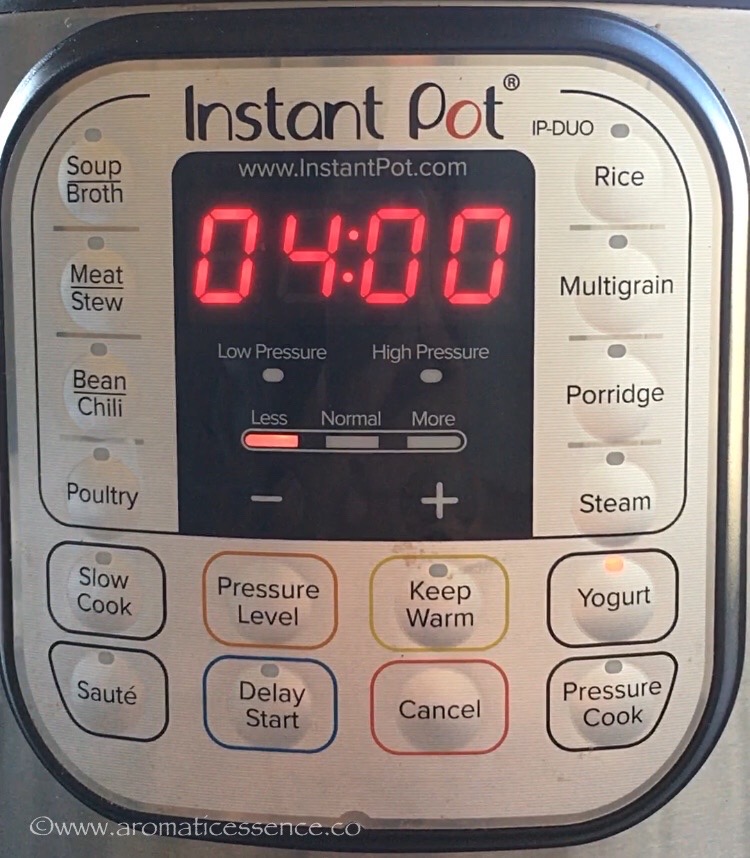
Step 6: The dough looks like this after proofing
After 4 hours, remove the lid, the dough will have risen and the surface will be dotted with bubbles. So far, so good, carry on with the next steps.

Step 7: Shape the dough
Dust your hands and work surface with about 2 tablespoons of flour. Transfer the dough to the work surface, scatter another tablespoon or so of flour. Using a bench scraper, fold the dough from the edges towards the center, until it forms a rough ball. Turn it around a few times until it forms a ball. Refer to the video for the shaping process.

Step 8: Second proofing
Line the inner pot of the IP with parchment paper, transfer the dough to the parchment paper, sprinkle some flour.
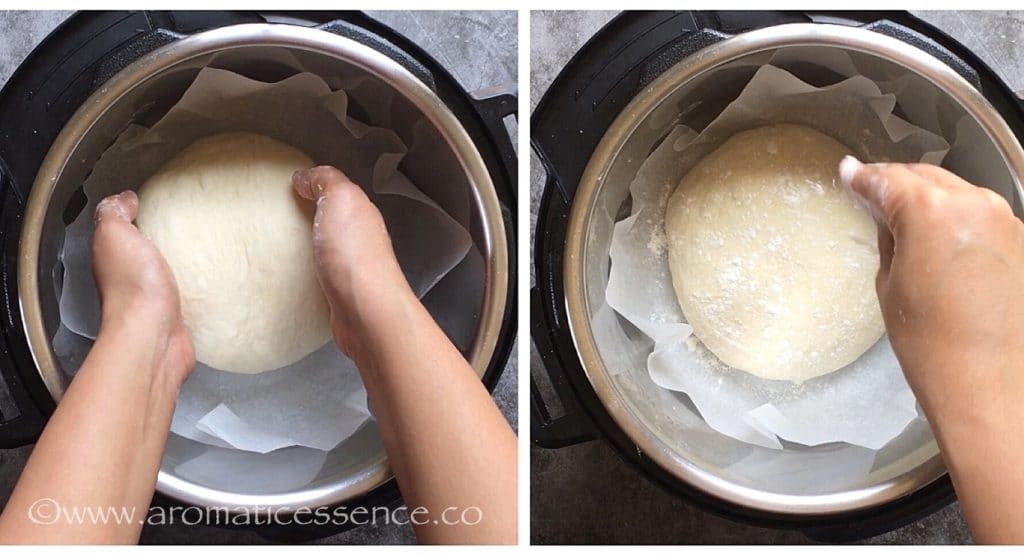
Cover the pot with a glass lid/plate/aluminum foil. Press the ‘YOGURT’ button, set it to ‘LESS’ OR ‘NORMAL’ setting. Set the timer for 30 minutes using the +/- button.
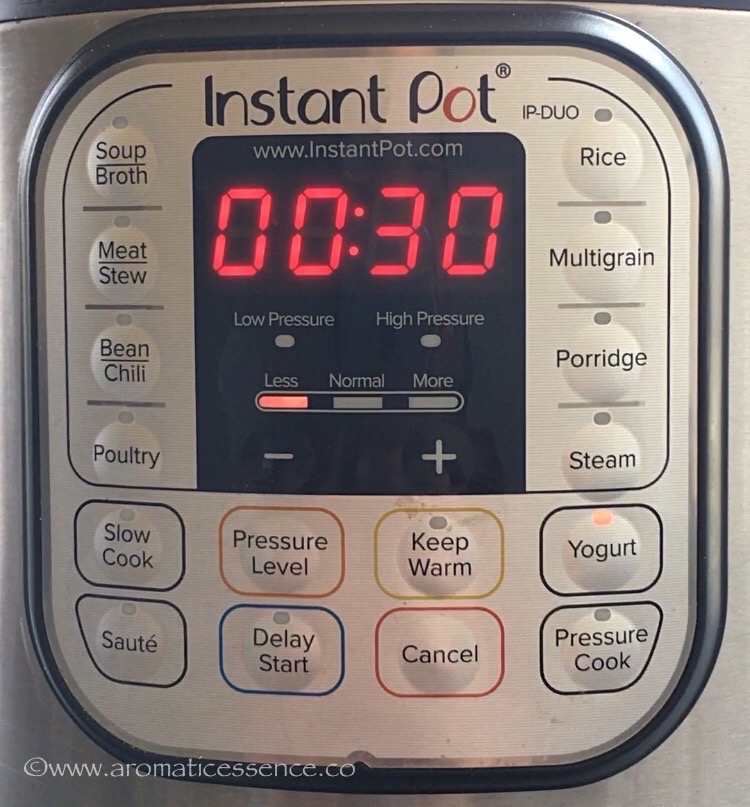
Step 9: Preheat the dutch oven
While the dough is proofing, preheat the oven to 450 degrees F. Place a 3.5 or 5-quart enamel-coated dutch oven with the lid in the middle rack and preheat it for 30 minutes.

Step 10: Bake the bread
After 30 minutes, remove the hot dutch oven carefully, and place it on a wire rack. Open the lid, transfer the dough along with the parchment paper directly into the hot dutch oven. You may score/slash the bread with a sharp floured knife, at least 1/2 inch deep at this stage.
Cover the pot with the lid, and bake at 450 degrees F for 30 minutes. After 30 minutes, remove the lid, and continue baking for another 15 minutes until the top is a golden brown or until the center of the bread registers 200- 210 degrees F on an instant-read thermometer. If you tap the bottom of the loaf, it should sound hollow and that’s how you know the bread is done.
So you are baking the bread for a total of 45 minutes (30 minutes covered and 15 minutes uncovered).

Step 11: Cool the loaf
Remove the loaf carefully, and transfer to a wire rack. Remove the parchment paper. Let the loaf cool for at least 1 hour before slicing. The bread continues to cook even when it is out of the oven, cutting it while it is still hot may not give you the desired crumb texture.

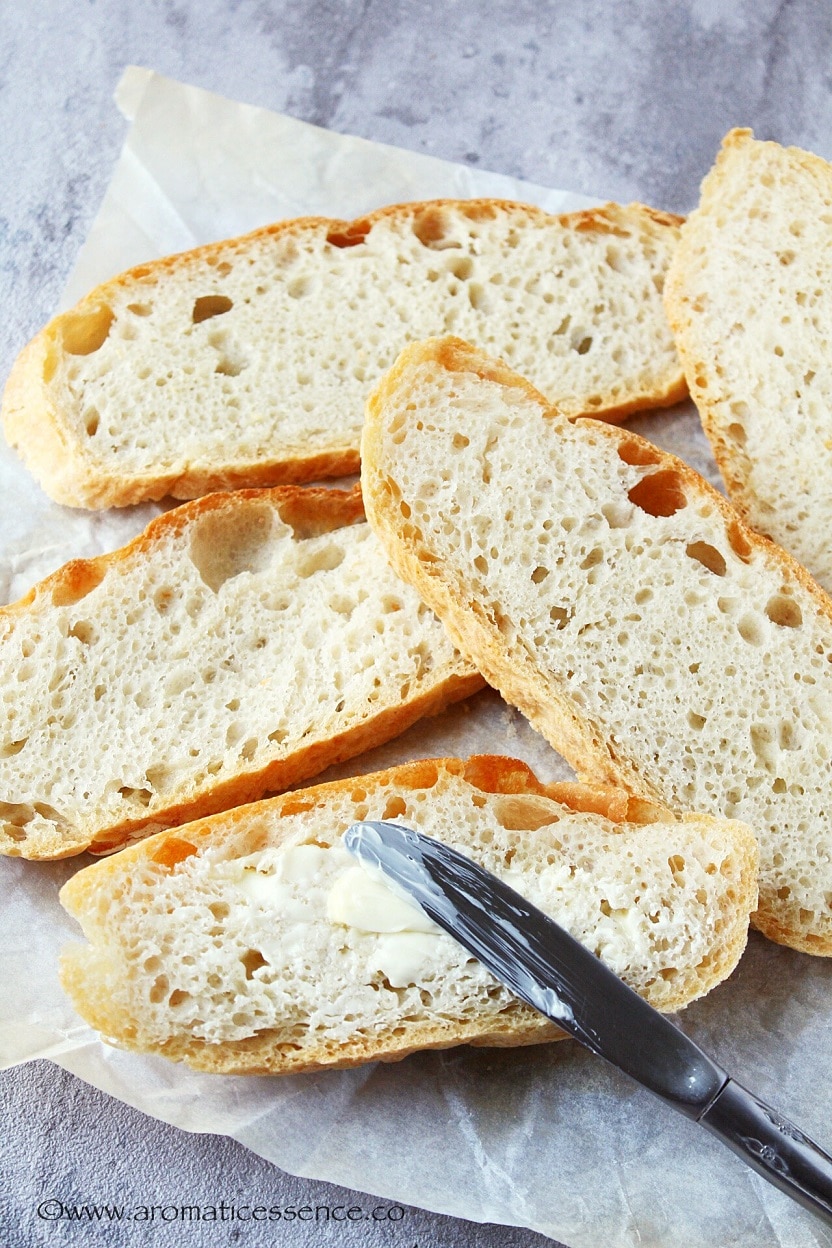
Important Notes
- The original recipe calls for 1.5 cups of water. But that quantity has never worked for me, I have a really tough time shaping the dough. Secondly, the crust gets crinkly after cooling and turns soft. I’m no expert, but I guess it is due to the humidity in Southern US, due to which I had to adapt the recipe. These quantities work perfectly well for me. Also, I always measure the flour and water with a scale.
- If you live in a dry region, chances are that you will not have that problem, I’d recommend using the 1.5 cups of water.
- Any kind of yeast works for this recipe. If you are unsure about the yeast, activate it first as mentioned above, and then proceed with the recipe.
- Remember not to overwork the dough at any stage, it is not called no-knead for no reason. The less you work the dough, the better the crumb texture will be.
- You can shape the dough directly on the parchment paper, then simply lift the paper along with the dough, and dump it in the IP for the second proofing.
★ If you try this recipe, I would love to hear from you! I’d appreciate it if you could rate and leave a review below in the comments. Your reviews help others know the recipe better too. Feel free to share your feedback and suggestions at [email protected]. Thanks so much 🙂
You can also follow me on Facebook, Pinterest, Instagram & Twitter

Dutch Oven Bread {Proofing Dough In The Instant Pot}
Equipment
- Instant Pot DUO60 6 Qt 7-in-1
- 3.5 or 5-quart enamel coated dutch oven
Ingredients
- 3 cups bread flour 430 grams, 3-4 tablespoons more for dusting
- 300 ml water (approx 1 & 1/3 cup) 300 grams
- 1/2 teaspoon instant yeast
- 1.5 teaspoons kosher salt
- 2 tablespoons olive oil, optional
Instructions
- Line the inner pot with parchment paper, grease with oil spray or a tablespoon or two of olive oil.
- Combine flour, salt, and yeast in a big bowl, and whisk well.
- Add water and olive oil, stir well with the help of a spatula or wooden spoon, until all the flour has mixed well with the water, and no dry flour pockets remain. The dough should look shaggy and be sticky at this stage. If not, add a few tablespoons of water, about 2-3 tablespoons should suffice.
- Transfer the dough to the greased parchment paper, cover the pot with any other lid or a plate or even aluminum foil. As a precautionary step, avoid using the lid of the IP.
- Press the 'YOGURT' button, set it to 'LESS' OR 'NORMAL' setting. Set the timer for 4 hours using the +/- button.
- After 4 hours, remove the lid, the dough will have risen and the surface will be dotted with bubbles. So far, so good, carry on with the next steps.
- Dust your hands and work surface with about 2 tablespoons of flour. Transfer the dough to the work surface, scatter another tablespoon or so of flour. Using a bench scraper, fold the dough from the edges towards the center, until it forms a rough ball. Turn it around a few times until it forms a ball. Refer to the video for the shaping process.
- Line the inner pot of the IP with parchment paper, transfer the dough to the parchment paper, sprinkle some flour.
- Cover the pot with a glass lid/plate/aluminum foil. Press the 'YOGURT' button, set it to 'LESS' OR 'NORMAL' setting. Set the timer for 30 minutes using the +/- button.
- While the dough is proofing, preheat the oven to 450 degrees F. Place a 3.5 or 5-quart enamel-coated dutch oven with the lid in the middle rack and preheat it for 30 minutes.
- Dough after the second rise
- After 30 minutes, remove the hot dutch oven carefully, and place it on a wire rack. Open the lid, transfer the dough along with the parchment paper directly into the hot dutch oven. You may score/slash the bread with a sharp floured knife, at least 1/2 inch deep at this stage.
- Cover the pot with the lid, and bake at 450 degrees F for 30 minutes. After 30 minutes, remove the lid, and continue baking for another 15 minutes until the top is a golden brown or until the center of the bread registers 200- 210 degrees F on an instant-read thermometer. If you tap the bottom of the loaf, it should sound hollow and that's how you know the bread is done.
- So you are baking the bread for a total of 45 minutes (30 minutes covered and 15 minutes uncovered).
- Remove the loaf carefully, and transfer to a wire rack. Remove the parchment paper. Let the loaf cool for at least 1 hour before slicing. The bread continues to cook even when it is out of the oven, cutting it while it is still hot may not give you the desired crumb texture.
Video
Notes
Nutrition


Hi Freda,
I have made this recipe many times with different variations and it is always delicious! I do have a question for you though. Would it be okay if I went through the first proofing process in the IP, worked the dough into a ball, and placed it in the fridge for a couple of days?
Thank you so much,
Noreen
Hi Noreen! Glad to know that you’ve been enjoying this recipe 🙂 Yes, it should be ok. You could shape the dough or store the dough without shaping it (after the first rise) in an airtight container that’s large enough, since the dough will continue to rise. Make sure you use an air tight container or the dough will dry out.
If you store the dough as such, you can shape it while it is still cold and leave it for an hour or so until it doubles in size. If you’ve already shaped the dough and then refrigerated, you can leave it on the counter for some time, if it has not doubled in the fridge. Then bake as directed. Hope this helps. Do let me know if you try.
I made this bread today. It is delicious! It has a terrific texture and a crunchy crust. I’m wondering if the recipe could be doubled for a 6 qt Dutch oven?
Hey Cathy! Glad you enjoyed it 🙂 Yes, you could double the recipe for a 6 to 8 qt Dutch oven.
I plan to make this bread ASAP. I’d like to include a bit of whole wheat flour. I know that WW flour is more dense. Do you have a suggestion for replacing some of the bread flour with WW flour? And if I do, should I add more water? thank you.
Hi Lori! That’s right, you may need a little extra water. I haven’t tried, so I’m not sure of the exact quantity, I guess 2 to 4 tablespoons of water should be enough.
Thank you! Also, looking forward to making the “sour dough” version, in the comments, with homemade greek yogurt (which I make in my IP).
That’s great! I hope it turns out well 😊
This is now my go-to recipe for making no-knead bread. I added WW flour and next time I may add a wee bit of rye flour. It was delicious. Thank you.
Great to hear that, Lori 😊 Once you master the basic recipe, it’s fun to experiment with other flours and flavors 😃
I wanted to ask if the 3 Quart instant pot would be big enough. My 6 quart doesn’t have the yogurt function.
Hi Barb, it should work just fine. Do not use the Instant pot lid to cover the pot, use any other glass lid, plate or plastic wrap to cover the pot.
What is the temperature of the water that is added to the no knead dry ingredients?
Hi Mar! It is room temperature water.
I followed your recipe exactly as written and the bread was so good. Based on other’s no knead recipes, the dough came out too wet and sticky (as you had mentioned). Your recipe had the dough dryer and therefore it was easier to handle.
My very first loaf no-knead bread looked exactly like your first loaf! I agree with you, the Instant Pot is a game changer! Now my only issue is when to start the dough so I can serve fresh bread for lunch!
I am very new to bread baking and your notes were super helpful. I strongly recommend that any one who is going to bake this bread should read the notes! I skipped the notes the first time, went right to the recipe and realized that I missed a lot!!! Additionally, it was also very helpful to read the reviews.
Thank you!
Hi Mar! I’m so happy to read your positive review! I understand that the post is lengthy and not everyone has the patience to read a long post. But sometimes, a certain post like this does need it. Even though this is a very simple recipe, some tips definitely help and I’m really glad you found them useful. Thanks for reading and taking the time to share your feedback. I truly appreciate it 🙂
do you have a recipe for focaccia bread? I looked, but didn’t see???? And I have a question for you…do you think that a focaccia dough that was placed in the refrigerator to rise for x amount hours…could then be placed in the instant pot/on the yogurt setting for the second rise? Like you said, put the dough on oiled parchment paper…You seem like you would know this! I am your fan!! If you don’t know, that is ok too! It isn’t your job!! Thank you for considering my question!
Hi Mar! Thank you for your kind words 🙂 I don’t have a recipe for focaccia currently, but I do intend sharing it in the coming months. I haven’t tried refrigerating the dough and then using the IP for the second rise, but I’m pretty sure it should work out fine. It will definitely cut back on your time for the second rise as opposed to letting it sit at room temp. Please let us know how it turns out if your try 🙂
Hi there, I have an old pressure cooker (not an IP but similar, pretty heavy duty). Instead of cooking the bread in that, and since I don’t have a dutch oven, could I put the dough in the pot and bake it in the oven as normal? I think it would withstand the preheat as it can withstand pressure cooking.. what do you think? thanks!
Hi! I’ve really not tried it so I’m not sure how it would work out. You will need to experiment. I think it should work out fine as far as there are no plastic components, since most handles are made of plastic. Also, you should remove the gasket and the vent weight (whistle) since we don’t need the pressure here.
I found this after searching for ways to improve proofing in a currently very chilly NYC. Just tried this recipe yesterday and it came out wonderfully! I had been thinking about getting rid of my Instant Pot since I use it so seldomly, but i think I’ve found a new purpose for it! I also think I’ve picked the worse time of the year to try to create a sourdough starter and wonder if the yogurt setting could be helpful with that… thank you!
Glad the IP came in handy to proof the dough, Martin. I’m really sorry, I have no experience with sourdough. But I’m sure the IP will help you save time. You may have to experiment with the timings. Good luck!
Hi Stephanie, you said you let yours sit for 18. Is that 18 hours in the Instant Pot to proof? If yes, did you also do the second proofing?
Teeny, 18 hours is outside. Yes, you still need to do the second proofing after shaping the boule.
I tried the link and it still didnt work until I opened it in a different browser, now I can view it. I look forward to using your recipe and using my Instant Pot for the proofing, it is cold out these days 🙂 Thank you.
That’s really strange. It works for me in chrome. Do share your feedback when you do, would love to know how it turned out 😊
Hi Freda, I am looking for the video for DUTCH OVEN BREAD {PROOFING DOUGH IN THE INSTANT POT}, but in is not in the recipe anymore. Can you post the link? Thank you.
Hi Teeny! I do see the video in the recipe card. Probably there was a glitch earlier. Here’s the link – https://aromaticessence.co/dutch-oven-bread/#recipe-video
I am wanting to attempt making Pumpernickel bread, would this proofing method work for that do you think?
If I made the recipe you shared, which sounds delish btw, I don’t have a dutch oven but I do have a 10 in. cast iron pan though I don’t have a lid for it. What do you recommend to use for a lid?
Hi Lisa! You can proof any type of dough that contains yeast in the Instant Pot. The timing will differ. You can use a glass lid to keep a tab on the timing.
You can try making a no knead skillet bread using your cast iron pan. Skip covering it with a lid. Also, you don’t need to preheat the cast iron skillet here. Grease and flour the bottom of the skillet. Transfer the boule, cover and let it rise for the second time. Preheat the oven to 450 degrees F. Bake until the top is crusty and golden brown.
Hello!!
Question: I started proofing the bread in my IP for about 3 hours before realizing that I need to leave for something tonight. Do you think I can turn off my IP and continue to proof for about 6 more hours at room temp?
I’ve made this before and LOVE it.
Hi Jenn!
Proofing it out at room temperature for 6 hours shouldn’t make much of a difference.
You can also refrigerate the dough in a sufficiently large container, covered. When you are ready to bake,remove the dough and follow the procedure of shaping and letting it proof for the second time in the IP. You will have to add a few minutes more because the dough is cold, it will take a few minutes extra to rise and double in size.
Glad to know you love this 😊
Is 1/2 tsp of yeast correct? My loaf turned out pretty small and it was a dense but delicious with a wonderful chewy crust.
Hi Margaret! Yes, 1/2 teaspoon of yeast is correct since this dough needs a long time to rise. It could have turned dense if you added more flour than specified, especially during shaping the boule. I’m glad you still enjoyed it 🙂
If doing the quick proof suggestion (in the oven, oven off, for 4-6 hours), do you only proof the dough once? The instapot version using yogurt function has 2 proofings. How many times would I proof in the oven? If twice, would you use the same method?
Hi Nikki, you can proof it the second time in the oven too following the same method until the dough doubles in size. Check the dough after 20-25 minutes. You don’t want to over proof the dough as the bread won’t expand as much on baking.
When I followed this recipe the dough is actually runny, so much so that I poured the dough into the instapot. I used regular yeast and the same amount of flour and water the recipe called for. I live in the south – could 1 1/3 c water be too much?
Hi Martha! The original recipe calls for 1.5 cups of water, which actually never worked for me. 1 and 1/3 cup worked well for me. Is it possible that you’ve used less flour by any chance? Because I’ve never had this issue of runny dough even with 1.5 cups of water. The problem with that was it was too difficult and sticky to shape it. I don’t suggest cutting back more on the water as that moisture is needed for this no knead recipe. May be try reducing it to 1.25 cups at the most or you can try adding couple of tablespoons of flour if you have the same issue next time. But avoid adding too much flour or else you will not end up with that airy crumb. Use a bench-scraper to shape this sticky dough. It definitely makes the job easier. You can try half a batch and check the consistency to see what works best for you. Hope this helps.
The directions were clear and the notes very informative. I added Kalamata olives and fresh rosemary. The bread came out perfectly! It was an instant hit!
So happy to hear this, Ana! Thanks for coming back and letting us know how it turned out 🙂
This bread turned out perfect, just like your picture! My lazy girl suggestions: I mixed the dough in an ice cream bucket then set the bucket into the Instant Pot to proof, with the rack at the bottom. This eliminated a bit of the mess. When ready to form I turned the dough onto my Silpat silicone mat, shaped the dough with my bench scraper, then put parchment paper on top of the dough and flipped the silicone mat over. Perfect loaf shape.
Also, if I have any whey on hand I use whey instead of water, which gives the bread a wonderful flavor. The whey comes from straining homemade yogurt (Instant Pot) and this bread is a perfect use for it.
Great suggestions, Joyce, hope it benefits others reading your comment too 🙂 Love the use of whey here, I usually use it for kneading roti dough. Next time, I’ll try using it in this recipe. Thanks so much for sharing your feedback 🙂
great recipe ! also please suggest how to bake this in oven
Hi Binal! If you go through the alternatives in the post under FAQ, you will find a couple of options listed. Hope that helps.
Wow, I’m in love with this bread, it’s max tasty and also my first time making this sort of bread. Addicted. Currently proofing my second one.
Is it possible to make it a bigger bread? I’m using a 4.2 quart (I think) dutch oven atm. I’ve received requests from the family but can only do one at a time @_@
Thanks!
Hi Gina! So glad to hear that 🙂 There’s nothing like fresh homemade bread, and this is such an easy recipe. I’ve not tried doubling the recipe. But I’ve read that you can, it could take about 70 mins total to bake the bread.
Thank you so much for this recipe!!! The taste and texture is amazing! I have always been intimidated in making bread thinking it was this long complicated process, but this recipe made it so easy. It was my very first time making bread, it came out wonderful. It had a nice crunchy surface and a soft and tasty interior. It took me 4 mins to mix the ingredients and I let mine sit for 18 because I didn’t want to make the bread till the next day. I did the rest of the steps and Bam! Homade delicious bread. THANK YOU!!
Hi Stephanie! Thanks so much for sharing your wonderful feedback. I’m so happy to hear this 🙂
I just baked this bread loaf and it looks amazing. I will have a hard time waiting an hour to start slicing the loaf.
The recipe was very easy to follow and with proofing for four hours, I got my errands done. Perfect. Thanks so much.
Hi Paulina! So glad to hear this! I know, that really is the hardest part. I hope you enjoy it, thanks so much for posting your feedback 🙂
Hi there! I want to do a cheddar jalapeno loaf, do I need to adjust the ratios or cook time? Also how much cheese and peppers should I add?
Hi Andrea, you can add 1 to 1.5 cups of shredded cheese, and 1 jalapeño pepper, seeded and sliced. Add it in step 2 after mixing the dry ingredients, then add the cheese and peppers, pour water, and mix it well.
This is by far the best no kneed bread recipe I have tried. I love that you measure everything, I truly think that is the best way to bake.
Thank you,
Noreen
I couldn’t agree more, Noreen! Thanks so much for coming back and sharing your feedback, I really appreciate it 🙂
Hi Frida! This is my go to bread recipe now. I have tried MANY others but I always come back to this one! Today I have added a 3 cheese blend , granulated garlic, chopped rosemary & fresh garlic oil EVOO (Costco). Once again thanks for your precise directions and metric system of measuring. I truly think that’s what makes this recipe so successful!
My daughter in law loves yogurt bread. Is there any way I could substitute the yogurt for water in this recipe?
Again, thank you so much… Noreen
That sounds delicious, Noreen! I’m glad you you love it 🙂 I’ve not tried using yogurt, but yes, you can definitely use it in this recipe for a quick sourdough bread of sorts. I’m afraid, I won’t be able to give you accurate quantities, but about 430 grams, that’s roughly 1.5 cups of Greek yogurt should work well. Add it gradually, and mix until you reach that shaggy dough stage. If it looks too dry, add a couple of tablespoons more of Greek yogurt. The rest of the procedure would stay the same. Would love to know how it turns out if you happen to try 🙂
Thank you Freda so much! I will definitely let you know how it comes out 😋 Can’t wait to try it!
Awesome! 🙂
Hi Freda, I wanted to let you know that your recipe with the yogurt in place of water turned out superb. The texture was very chewy and the taste was similar to a sourdough. My daughter in law loved it! Thank you!! Noreen
That’s awesome, Noreen! Glad it turned out well 😃
Good afternoon,
I want to add roasted garlic to my recipe. Would I need to adjust the liquid in the recipe?
Hi Tina! You will not need to adjust the liquid. Try with the quantity I’ve mentioned first, if it seems too dry, then add the entire 1.5 cups of water.
i do not have a dutch oven or a alternate pan . can I insert it into the oven without using a pan?
Hi Denise, you can use a regular baking sheet if you don’t have any of the alternatives mentioned. After the second proofing, transfer the risen dough on a greased baking sheet dusted with little cornmeal. Also, place a cup of water in a shallow baking pan in the lower rack. Bake the bread on the middle rack as directed in the recipe for 30-45 minutes or until the crust is golden brown. Hope this helps, please feel free to let me know if you have any doubts.
Hi Freda,
Thank you so much for sharing this. I have a 7.5qt dutch oven. Do you think increasing the ingredients by half is enough, or do I need to make a double recipe, given the larger sizes pot? Thanks.
Hi Cais! You are most welcome! Honestly I’m not sure, as I’ve not tried scaling this recipe. I’d suggesting increasing by half to begin with. Do share how it turns out 😊
I don’t have a dutch oven but I do have a vintage Corning 5 qt square casserole dish with a glass lid. Do you think this will work as a dutch oven?
Hi Darylle, I just researched a little about it, and it seems like it should work. Though I won’t suggest preheating the casserole dish. Place the dough along with the parchment paper directly in the casserole dish for the second proofing on the countertop. I think I would also reduce the temperature to 425 degrees F. Preheat the oven to 425 degrees for 30 minutes, after the second proofing, cover the casserole with an aluminum foil and bake as directed. I’m not really sure about the glass lid to cover the dish, so I would avoid it. Unless you have used both the dish and the lid earlier in baking at such high temperatures, then you could bake at 450 degrees along with glass lid. And follow the same procedure, bake covered for 30 minutes and uncovered for 15 minutes.
I make this bread often, can,’t wait to try the IP version.
I have a question about the Dutch oven….I always find the bottom of my bread is very hard, I assume it’s because it’s the only part of the dough touching a surface but is there something I can do to soften the bottom? I have baked it in traditional loaf pa s but then it loses the beautiful rustic shape.
Hi Lori, I have not had that problem with the no-knead bread recipe. Could it be that the oven is hotter at the bottom? Do you put it directly in the dutch oven or put it along with the parchment paper? Once the bread has cooled down, place it in an enclosed container or plastic bag, that should help in softening it. Please do let me know if this helps.
Hi! I’ve had the same issue. I tried 425 for the same amount of time and it fixed the issue. Maybe our ovens run hot!
To keep the bottom of bread from over cooking in a dutch oven (I do this for sourdough as well), I put polenta or cornmeal in the bottom of the pan and circle of parchment paper over that, then the parchment paper the bread is on goes on top of that. I also put a cookie sheet or baking stone on the rack below to deflect the heat from the bottom element.
Thanks for sharing, Molly 🙂
Hello. I managed to make a pretty no knead bread but there’s a issue with my parchment paper stay put on the bread even I dust the parchment paper properly. What should I do?
Hi Renee! Ideally the parchment paper releases pretty easily after the bread is baked, I’ve not faced this problem. Which brand of parchment paper did you use? I would just slice off the bottom and use the bread. Next time, probably try dusting more of flour or cornmeal to avoid this problem.